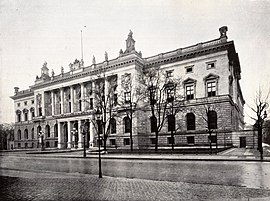Prussian House of Representatives
|
Prussian House of Representatives Preußisches Abgeordnetenenhaus |
|
|---|---|

Façade on Prinz-Albrecht-Straße, c. 1900
|
|
| Type | |
| Type | |
| History | |
| Established | 5 December 1848 |
| Disbanded | 15 November 1918 |
| Preceded by |
Prussian estates Prussian National Assembly |
| Succeeded by | Prussian Landtag |
The Prussian House of Representatives (German: Preußisches Abgeordnetenhaus) was, until 1918, the second chamber of the Prussian Landtag, the other chamber being the Prussian House of Lords. It was elected according to the three-class franchise, and had been established by the Prussian constitution of 5 December 1848. The name "House of Representatives" (Abgeordnetenhaus) was introduced in 1855.
From 1849 the election of representatives within the Kingdom of Prussia was performed according to the three-class franchise system. The election procedure was indirect. In the primary election, those with the right to vote went to the ballot and, in three separate classes, chose electors, who, in turn, chose the representatives for their constituency.
Several attempts to reform the voting procedure, which heavily favoured the Conservatives, were rebuffed by the House of Lords. The electoral law, which was one of the most progressive in Europe at the time it was introduced, thus stayed mostly unchanged until 1918. The House of Representatives itself decided to abolish it in 1918, but hat became redundant by the German Revolution of 1918–1919, which founded a republic.
The right to vote was open to every male Prussian over 24 years of age who had been living in a Prussian municipality for at least six months and had neither been stripped of his rights by a court of law or was in receipt of public pauper relief. To stand for election as a representative, one had to be over 30, be a Prussian for at least three years and not be stripped of civil rights by a court.
The legislative period was at first three years, but, as for the Reichstag, it was changed to 5 years in 1888. The House was, however, dissolved by the king prematurely several times. From 1849 to 1918, there were 22 legislative periods.
Its size was first fixed at 350 seats, which changed to 352 with the incorporation of Hohenzollern-Sigmaringen and Hohenzollern-Hechingen in 1849. Following annexations after the Austro-Prussian War of 1866, the number of seats changed to 432 after the election of 1867. In 1876, another seat for the Duchy of Lauenburg was added. In 1906, ten seats were added, bringing the number to 443 for the elections of 1908.
...
Wikipedia
